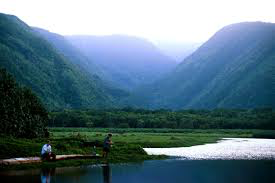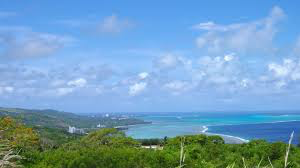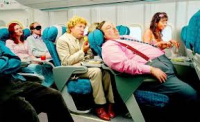Luke and Lily- Wild One
Hawaii Beach Adventure
Hawaii (North and South)
 The Big Island of Hawaii wears a thousand faces. Descending into northern Kona, the most populated community on the island, gives the feeling of landing on the moon: black lava fields cover the earth then sink into the sea. Above the airport the mountain looks on. A steep grade climbs to forests that look like they belong to Minnesotan summers. The air is cooler up here and the sun is covered by lurking rain clouds. Two main roads run north and south. The higher road winding south leads to coffee farms and pocket towns that hold artists and small business owners. This road carries on for more than one would think an island road could carry on for. It eventually stops at Kilauea, the island’s only active volcano. Not only is the Big Island Hawaii’s largest island, but it’s the only island that hasn’t stopped growing. Kilauea ensures this growth.
The Big Island of Hawaii wears a thousand faces. Descending into northern Kona, the most populated community on the island, gives the feeling of landing on the moon: black lava fields cover the earth then sink into the sea. Above the airport the mountain looks on. A steep grade climbs to forests that look like they belong to Minnesotan summers. The air is cooler up here and the sun is covered by lurking rain clouds. Two main roads run north and south. The higher road winding south leads to coffee farms and pocket towns that hold artists and small business owners. This road carries on for more than one would think an island road could carry on for. It eventually stops at Kilauea, the island’s only active volcano. Not only is the Big Island Hawaii’s largest island, but it’s the only island that hasn’t stopped growing. Kilauea ensures this growth.
The road leading north of Kona keeps the Big Island’s loveliest beaches. They are set in the backdrop of black volcanic rock and dry, daunting land. These beaches are stretches of fine white sand and turquoise waters. The popular ones are easy to get to and have wonderful municipal facilities. The hidden ones are found with some hiking and a good guidebook, but are well worth the extra effort. If one continues to follow the coast northwards, the road climbs to a quaint hippy town called Hawi. Coffee shops and art galleries litter the streets and signs for open mic nights and yoga classes dress the light-posts. This activity bumbles on for two or three blocks then houses start amongst dramatic sea views and jungle lush and green as a garden with five owners.
The road eventually stops at Pololu Valley, one of five picturesque valleys that dip into the sea. A dirt path continues to the bottom of the valley, but one must tread it by foot. Here, a pebbly black sand beach is nestled perfectly adjacent to a fresh water stream that provides a safe place for swimming. Tall cliffs look on and a series of more paths reach towards the green interior: a curiosity for an adventurous traveler.
The journey forward involves prolific hiking accompanied by wild, timeless scenery. The terrain is steep, narrow, green, and kept only by nature. It is here where the ancient Hawaiians found the most fertile land, and considered these valleys as sacred as their gods.
To travel further by car, one must backtrack through Hawi and follow a mountain pass to descend into the sleepy country town of Waimea.
Kona Drive
It is unimaginable to think of carving a highway into the black lava rock that steeps towards the ocean. The strength of nature is matched by man’s creativity, but only with the help of time and thought. Faded african-colored grass struggles through dried lava cracks reaching towards the sun deepening for the water below. The mountain above starts with a cloud over bright green, flourishing trees, then continues like a step-ladder into colors that fade and sharpen with black and blue into the sea. When the air is clear and the sun is new, the sky is a canvas of fire trickling in bursts onto the greens, and grays.
This is my drive to work: a detailed observation of the Kona coastline that is parched and desert-like. On early mornings the road is bare. I count it a privilege to be in the middle of such wildness and untamed scenery. My eyes tend to  drift from the mountain peaks to the blue behind the green trees without much thought. They struggle, like a sailor in search for land, for the pattern of blues that stretch unto the horizon. Once found, the blue is a stark contrast of life and brightness against the fading desert lava rock.
drift from the mountain peaks to the blue behind the green trees without much thought. They struggle, like a sailor in search for land, for the pattern of blues that stretch unto the horizon. Once found, the blue is a stark contrast of life and brightness against the fading desert lava rock.
Herds of goats collect near settlements of pasture while braving sharp black rocks on their heels and toes. Other wildlife is scarcely seen, save for the occasional birds on route to the sea.
There is so much to the name of this island, the Big Island of Hawaii. It is vast, spacious and wild.
Rota
The flight from Saipan to Rota lasts for thirty minutes over a glassy sea close as a carpet. The nine seater plane shakes and wobbles like a popcorn machine at every thrust of wind and veer of the pilot’s hand. The first sight of green sends my vision to the coastline in search of a sandy bay or swimming hole. My eyes circle the island quickly then move to the interior to find a hidden trail or wild terrain suitable for an afternoon’s exploration. The plane shakes again as we descend onto the small airstrip. I’ve already memorized the island, from the vantage point of a bird. The airport is quiet and small. Those who are working offer smiles, waves, welcomes, and a hand for our luggage.
The rental car we find is fuel efficient and compact (not that fuel efficiency helps very much on coin-sized island). The car seat for our daughter, Lily, offers space enough for a giant’s baby or one destined for the NBA. We strap her in, tight as possible, study the map, then navigate our way to our hotel for the night.
Green shrubs, tall grass, and rogue coconut trees envelope the road. Houses or buildings appear like a scare rain during a dry season. People and fellow drivers appear even less, but  when they do they wave and smile as though they are our long-lost friends. We drive a little further: tar turns to narrow gravel roads hugging the coastline and tunnels of wild fauna, and dipping trees. The unfurling waves on our left seem big and close enough to overtake the road, but the jagged rocks on which they break are our protection and bordered fence.
when they do they wave and smile as though they are our long-lost friends. We drive a little further: tar turns to narrow gravel roads hugging the coastline and tunnels of wild fauna, and dipping trees. The unfurling waves on our left seem big and close enough to overtake the road, but the jagged rocks on which they break are our protection and bordered fence.
It’s a wonderful feeling for us: as though we’re the first explorers on a wild terrain surrounded by a sea that allows no harbor. For some, such a thought would bring claustrophobia and panic, but for us, the soil that holds no sign of civilization, emits the feeling of a boundless life. Rota is our playground for the weekend.
Our House in the Jungle
When I look outside my kitchen window, my eyes get lost in green and blue. The mountain falling down holds a thousand trees that strangle each other in a tropical stampede. Beyond the dense fauna sits a shy sea visible by clear day and hidden by mist. I imagine what types of animals could be living in the the thick jungle, but then I see a blue and white Kingfisher rest on a coconut and remember one important fact: Saipan is a tropical island free of snakes and any animals that pose a threat.
Behind my bedroom stands a tall water tank with a ladder on its side. Now and again I climb the rungs to the top of my roof and send my eyes to the horizon. From such a height, the sea seems braver and more inclined to greet me. If I stand on my tip toes I find where the turquoise, s hallow water meets the deep, dark blue. To the left and right I see no signs of civilization: the roads are hidden in shade and the houses are covered by the tropical expanse. The only movement in the scenery happens in the birds: white, blue, red, and yellow wings color the green backdrop.
hallow water meets the deep, dark blue. To the left and right I see no signs of civilization: the roads are hidden in shade and the houses are covered by the tropical expanse. The only movement in the scenery happens in the birds: white, blue, red, and yellow wings color the green backdrop.
The sounds on Mt. Tapochau are much like the scenery: free of overt human activity. The songs of birds ride the gentle breeze that reaches us. The trees bend and sway with a swoosh and rattling of leaves. The quiet gives voice to silent noise: pipes holding the day’s supply of water, ceiling fans spinning on their wheels, and blinds and curtains being tossed around by currents of air.
As I settle and meditate on this tranquility, I realize I’ve forgotten a vital detail. A lapse of peace unfolds, as I’m interrupted. Rosco, our dog, the neighborhood dog is talking. His moan gives way to a bark then a howl which runs and echoes through the silence like a siren on a Sunday afternoon.
Saipan Days
The Thursday Market
The Thursday Night Street Market has become one of our favorite visits. Restaurants on Saipan empty their kitchens on a grassy knoll beside the turquoise sea. A stage occupies the central space and holds a variety of local talent and culture. The smell of Asian cuisine falls into a salty sea breeze, while the red hot sun slips behind the  clouds. My stomach pulls me to the $1 BBQ sticks. I buy three while Kristy finds a coconut to sip. The tables are packed and leave little to no room for seating. We send our eyes towards empty spots that wane with passing time. We share a table with Japanese, Korean, or Chinese tourists mostly, and occasionally with a local Chamorro family. Few words are exchanged. But our delight is mutual: in the food, sights, and sounds of the Thursday Market.
clouds. My stomach pulls me to the $1 BBQ sticks. I buy three while Kristy finds a coconut to sip. The tables are packed and leave little to no room for seating. We send our eyes towards empty spots that wane with passing time. We share a table with Japanese, Korean, or Chinese tourists mostly, and occasionally with a local Chamorro family. Few words are exchanged. But our delight is mutual: in the food, sights, and sounds of the Thursday Market.
Young children race to keep up with their determined parents who are looking for the shortest line or their favorite food vendor. The music behind our ears is muffled by poor sound equipment. It usually comes in the form of American pop. Those brave enough take the stage and dance as though all of Saipan weren’t watching them. Waves of tourists and locals fill and empty, while the price of food dwindles and the music softens. We’re in the middle of the Pacific Ocean, under a clear night sky, celebrating our shared existence on this rare, beautiful island.
We bag our leftovers then make way for a narrow, gravel road that hugs the sea and avoids the busy traffic. The road back is quiet and dark. The smell of spicy food, salt and sweat keep with us until we arrive home, change our clothes, and fall asleep.
Hours into Days (Part 1)
Upon booking our return flight to Saipan, an attractive 23 hour “duration of journey” caught our attention: by far the best of our options as we scanned the flight schedule. Minneapolis to Houston, Houston to Honolulu, Honolulu to Guam, Guam to Saipan. Three stops seemed less than desirable, but the wait time between departures was perfect. And though it wasn’t quite the way the crow would fly, it seemed pretty close.
Minneapolis to Houston was a standard domestic flight: little to no room, packed like a tumble dryer, and void of any breakfast or coffee. Sleep kept us busy until the bumpy landing reminded us where we were. The Houston airport moved like a tropical jungle: all sorts of sights, sounds, and colors occupied our senses. Kristy stayed with the bags, while I stood in line for a healthy southern breakfast, if there is such a thing. As we finished our sandwiches, the loudspeaker informed us of a small 20 minute delay. No big deal, I thought. It’d still be less than a 2 hour wait.
The boarding line indicated a full flight, so we gave up on arriving to our spots early and watched seat-hungry passengers bid for their already reserved spaces. As we scuffled and weaved through fellow in-mates, I mean, passengers to find our seats, we quickly became depressed.
There they were: small, middle seats, riddled with claustrophobic energy. It wasn’t before long, after storing our bags in the undersized overhead compartments, that my pregnant wife burst into tears. These seats, the middle ones in particular, aren’t very accommodating to pregnant ladies. In fact, I’m not sure that they’re made for regular sized adults, pregnant or not.
So we set off like scurvy pirates in search of better spoils. Two 2-seaters apprehended our wandering eyes. Wonderful. We’d take one each, and drown our worries in an expanse of softish, hardish cushion, wrapped in blankets sized for mice. But, half-expected, as we buried into our new homes, a flight attendant quickly told us that these had already been taken. “By who?”, I asked. “These are the seats for the flight attendants,” she boldly responded. It makes complete sense to me now why the flight attendants should take the two-seaters, but at the time all I could think about was my pregnant wife in tears, and how this lady had now become responsible for all of it. “I think the flight-attendants should take the middle-seats. See how roomy they are.” She didn’t respond to my sarcastic comment: not my finest moment in dealing with strangers, but an honest one none the less.
As we turned to take our bedraggled bodies back to our horrible places, a lady sprawled across 3 front row seats turned to our aid.
“Well if you’re really pregnant then you guys can have these seats.”
We graciously accepted and thanked her for her kindness then assured her that Kristy was really pregnant. We had been rescued. Houston to Honolulu with room to straighten our legs and move without the feeling of being trapped in a matchbox.
